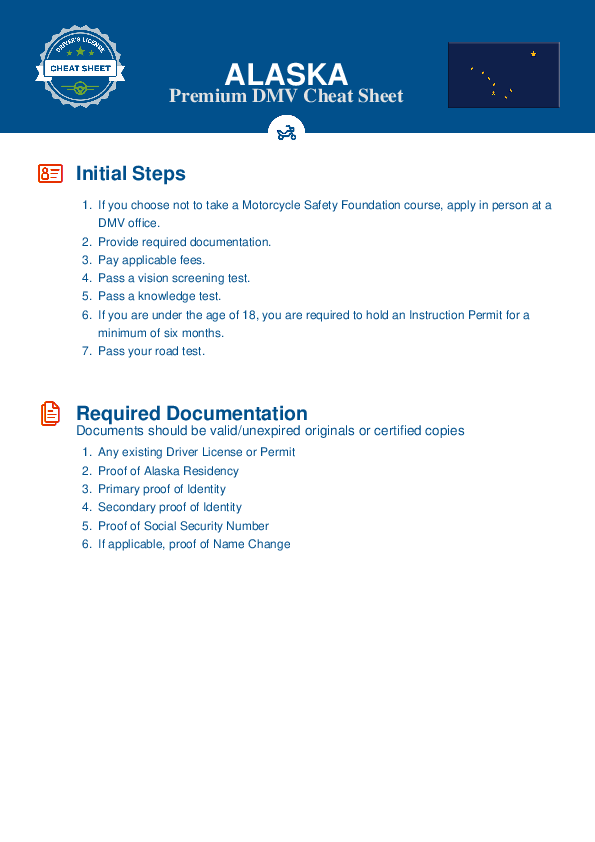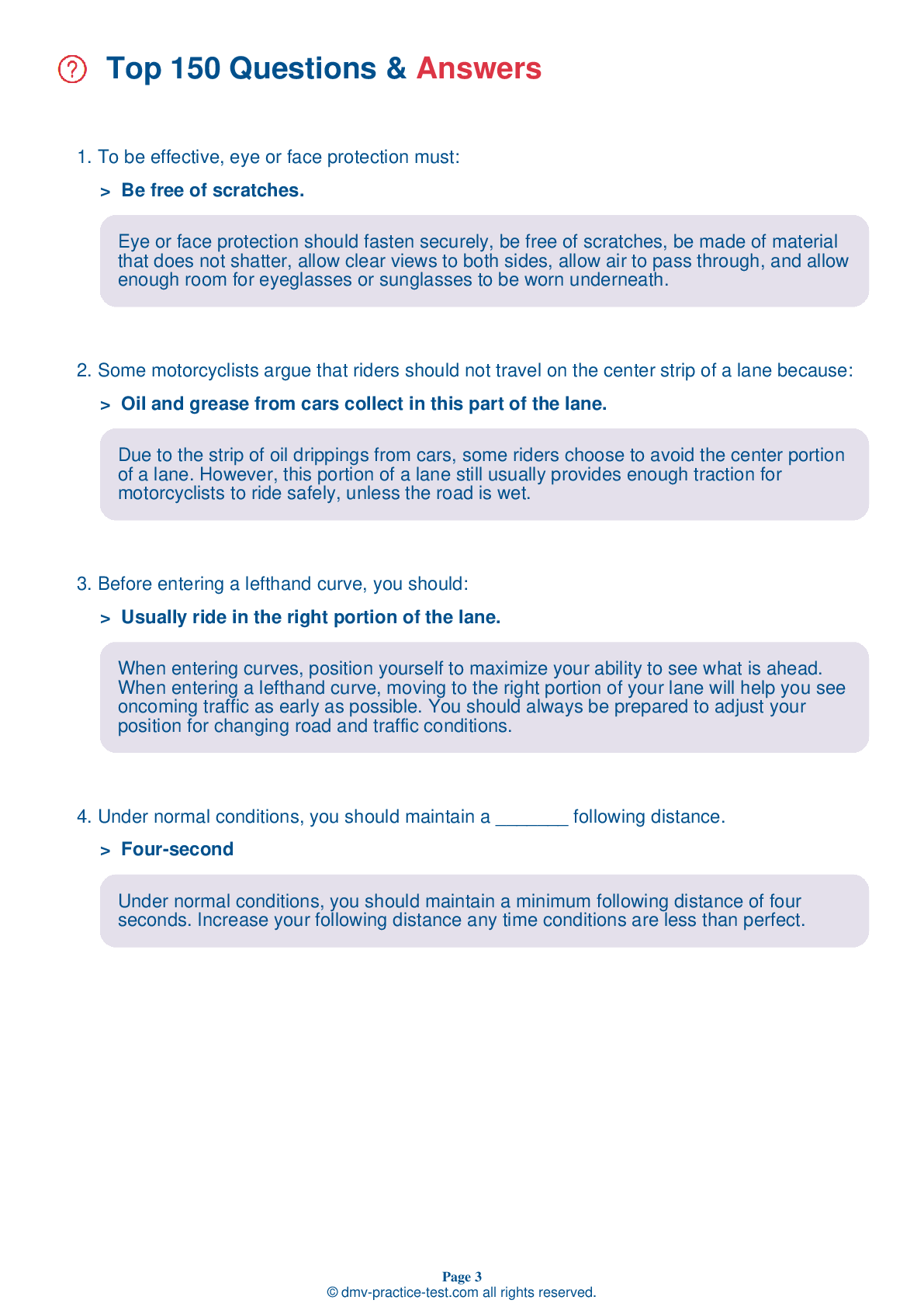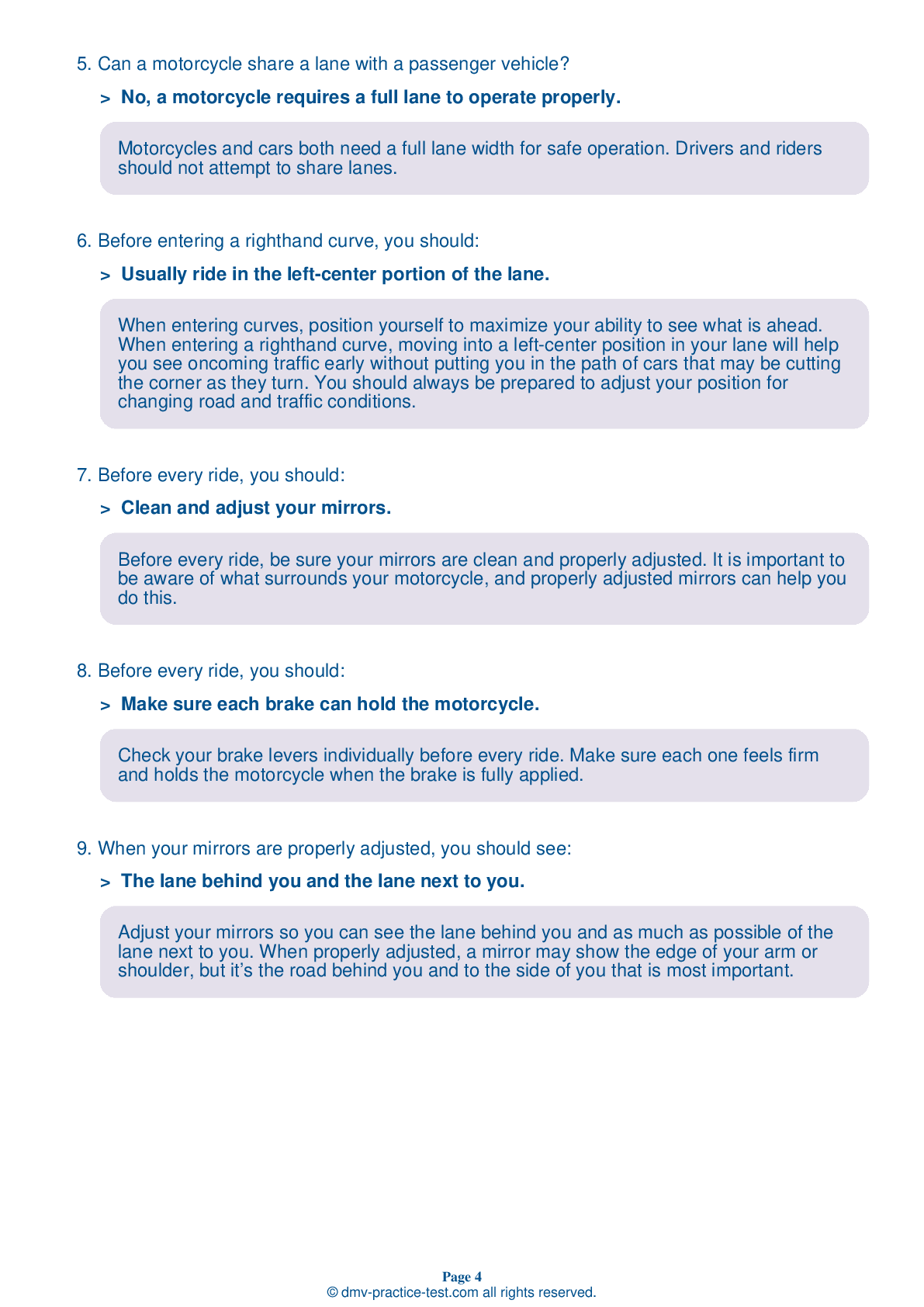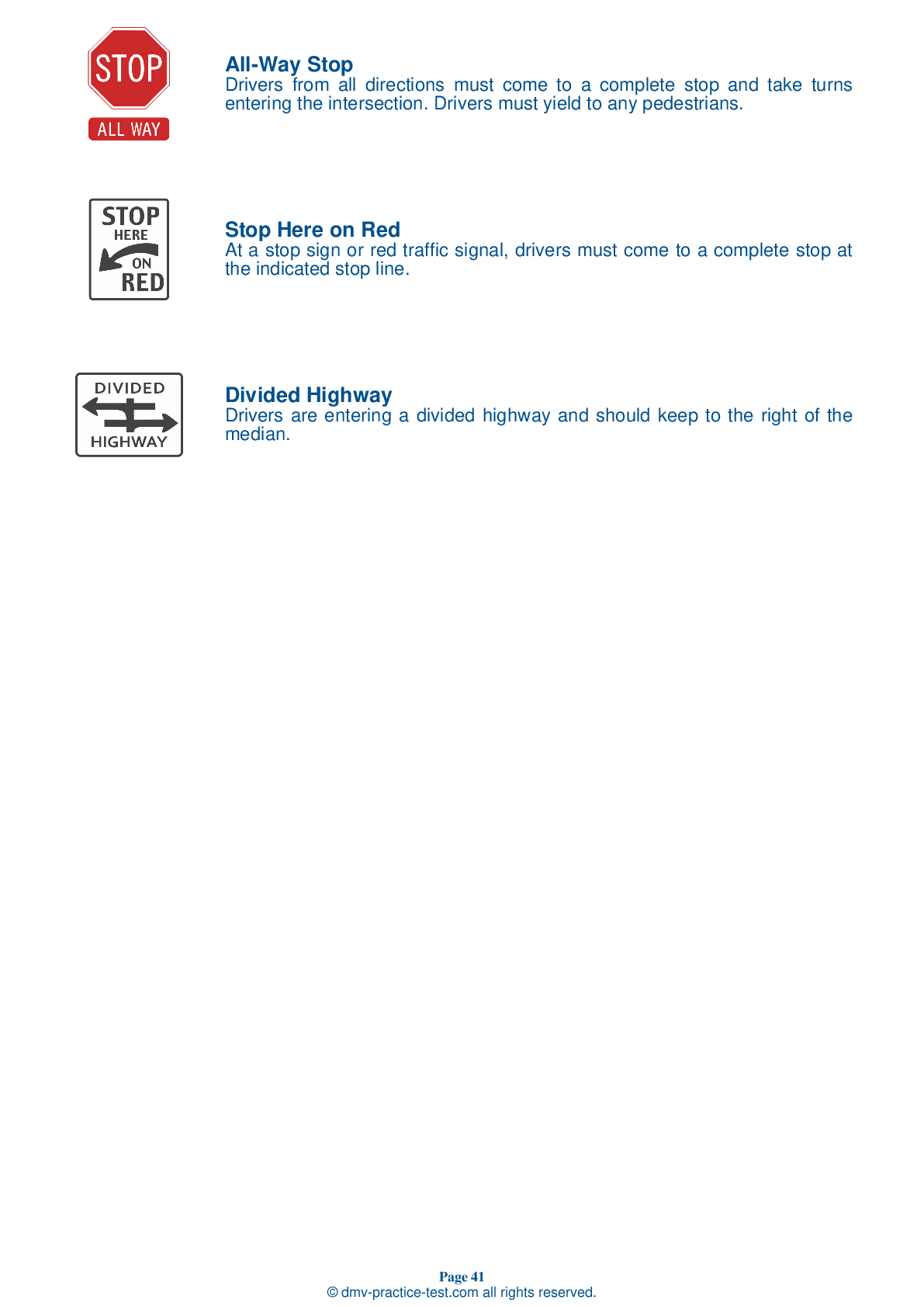DMV Permit Test #7
Motorcycle Test | License AK 2025 | FREE Online Practice! #7
Take this FREE motorcycle test (license in AK 2025) to check your knowledge of the road rules. To improve your results, download a motorcycle handbook online, study theory, and practice for free on our website. Still worried about how to get a motorcycle license in Alaska in 2025? Check our website for more sample tests, train as much as possible, and boost your grades!
25
20
16
1 . This sign means:
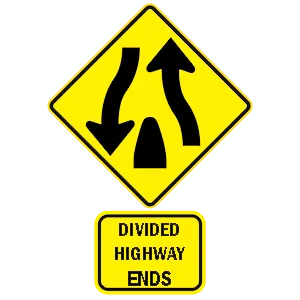
Keep left.
Warning signs are usually diamond-shaped with black markings on a yellow background. They alert drivers to upcoming hazards. This sign indicates that the divided highway is about to end.
2 . Before starting a turn, a motorcycle rider should change gears to:
Prevent a change in power in the middle of the turn.
It is best to change gears before starting a turn. Shifting gears while in the turn can cause a sudden change in power to the rear wheel, causing a skid. If you must change gears while in a turn, change gears smoothly to best prevent skidding.
3 . When riding your motorcycle, your feet:
Should be wherever you are most comfortable.
When riding, you should keep your feet firmly on the foot pegs near the controls. Firm footing can help you maintain your balance. Don't drag your feet along the ground or point your toes downward.
4 . Which of the following is not important when looking for a motorcycle helmet?
The helmet looks cool.
To ensure that a helmet will provide you with as much protection as possible, check to see if it meets U.S. DOT and state standards; fits snugly all the way around your head; and has no obvious defects, such as cracks, loose padding, or frayed straps.
5 . Of motorcyclists killed in crashes, tests have shown that _____ had alcohol in their systems.
Five percent
Drinking and riding is very dangerous. Tests of riders killed in motorcycle crashes show that 40 percent had alcohol in their systems when the accidents occurred.
6 . When riding with a passenger, you should:
Try to squeeze into smaller gaps in traffic.
The added weight of a passenger will affect the handling of your motorcycle. Expect your motorcycle to accelerate more slowly than usual, turn more slowly than usual, and require extra space to come to a complete stop. Ride more slowly, start slowing sooner when approaching a stop, open up a larger space cushion, and wait for larger gaps when crossing, entering, or merging into traffic.
Need Motorcycle Insurance? No problem!
Compare the best rates in Alaska and find a personalized policy that meets your needs.
1. Are You Currently insured ?
2. Married ?
3. Do you own your Home?
4. Have you or a Family Member Honorably Served in U.S. Military ?
5. Your Name
6. Age
7. Zip code
Ranked by best match
2025 Alaska | Frequently Asked Questions
To acquire a motorcycle license in Alaska, you must first obtain a motorcycle learner's permit. This requires passing a written test. After practicing with the permit, you can apply for a road test to get your motorcycle license. Applicants under 18 must also complete a state-approved motorcycle safety course before obtaining their license.
In Alaska, the minimum age to obtain a motorcycle license is 16 years old. However, those under 18 must have a parent or guardian's consent, must have held a permit for at least six months, and must complete a state-approved motorcycle safety course.
Yes, you do need a dedicated license to ride a motorcycle in Alaska. You must obtain a Class M1 or M3 license. The M1 license is for any motorcycle, while the M3 is specifically for three-wheeled motorcycles. These are separate from regular driver's licenses and require their own tests and fees.
To apply for a motorcycle license in Alaska, you'll need a valid Alaska driver's license, proof of identity (like a passport or birth certificate), proof of Social Security number, and proof of residency. If you're under 18, you'll also need parental consent. Remember to bring payment for the required fees. Always check the DMV's current requirements as they can change.
Yes, you will need to take a written exam for a motorcycle license in Alaska unless you complete a state-approved motorcycle training course. The written test covers topics like traffic laws, safe riding techniques, and handling emergency situations. You'll also need to pass an on-cycle skills test to demonstrate your ability to safely operate a motorcycle.
The motorcycle written test in Alaska covers a range of topics related to safe motorcycling. These include understanding road signs and signals, rules of the road, safe riding techniques, handling dangerous surfaces, carrying passengers and cargo, group riding, and alcohol and drug effects on motorcycle operation. The test is based on the Alaska Motorcycle Operator Manual.
In Alaska, completing a state-approved motorcycle training course can waive the need for a written test. The course provides both theoretical and practical motorcycle knowledge, which satisfies the written test requirement. However, you would still need to pass the on-cycle skills test to obtain your motorcycle license. It's always best to verify with your local DMV.
To enroll in a motorcycle training course in Alaska, you first need to find a state-approved provider. You can do this online or by contacting the DMV. Once you've found a course, you'll need to register, usually online or over the phone. The course typically includes both classroom and practical riding instruction. Completion of the course may help you bypass certain license testing requirements.
No, you do not need to own a motorcycle to take the license test in Alaska. You can use any street-legal, insured, and registered motorcycle for the test. However, it should match the class of license you're applying for. Proof of insurance and registration is required.
Yes, you can use a friend's motorcycle for the driver's license evaluation in Alaska. However, the motorcycle must be legally registered, insured, and in safe operating condition. Also, you should be comfortable and familiar with its operation. Always remember to bring proof of insurance and registration to the testing site.
Yes, during the motorcycle driving exam in Alaska, specific handling skills are tested. These include the ability to start and stop, turn and swerve, and negotiate intersections. The test also assesses your ability to handle a variety of traffic situations, your knowledge of road signs and signals, and your understanding of safe riding techniques.
Yes, new motorcycle drivers in Alaska are issued a learner's permit first. This permit has limitations: you can't ride after dark, carry passengers, or ride on highways. After practicing with the permit, you can take a road test to get a full motorcycle license without these restrictions.
Yes, your Alaska motorcycle license is valid for riding across other states in the U.S. However, you must follow the specific motorcycle laws of each state you pass through. It's always wise to familiarize yourself with these laws before your trip to ensure you're riding legally and safely.
In Alaska, motorcycle helmet laws are age-specific. If you are under the age of 18, you are required by law to wear a helmet when operating or riding on a motorcycle. However, if you're 18 or older, wearing a helmet is optional. Despite this, wearing a helmet is always recommended for safety reasons.
In Alaska, there's mainly one type of motorcycle license, called the "M" endorsement. However, there's a restriction known as the "3-Wheel Only" restriction if you take your test on a three-wheel motorcycle. To operate a two-wheel motorcycle, you must pass an additional road test to remove this restriction.
Yes, you can add supplementary endorsements to your motorcycle license in Alaska. These include a "3-Wheel Only" restriction if you pass your test on a 3-wheel motorcycle. However, to remove this restriction, you must pass another road test on a 2-wheel motorcycle. Always check with your local DMV for any specific requirements or changes.
Yes, the Alaska DMV provides the motorcycle license test in several languages other than English. However, it's advisable to contact your local DMV office in advance to confirm the availability of the test in your preferred language and to schedule an appointment.
An effective strategy for preparing for the motorcycle license test is to thoroughly study the Alaska Motorcycle Operator Manual. This guide covers all the information you'll be tested on. Additionally, you can take online practice tests to familiarize yourself with the format and types of questions on the actual exam. Make sure to also review road signs and rules.
Yes, the motorcycle written exam in Alaska can be taken in languages other than English. However, the availability of other languages may vary by location, so it's best to contact your local DMV office in advance to confirm which languages they support for the exam.
Yes, if you don't pass the motorcycle written test in Alaska, you are allowed to retake it. However, you must wait one day before you can retake the test. It's recommended to study the Alaska Motorcycle Operator Manual again before attempting the test for a second time to increase your chances of passing.
